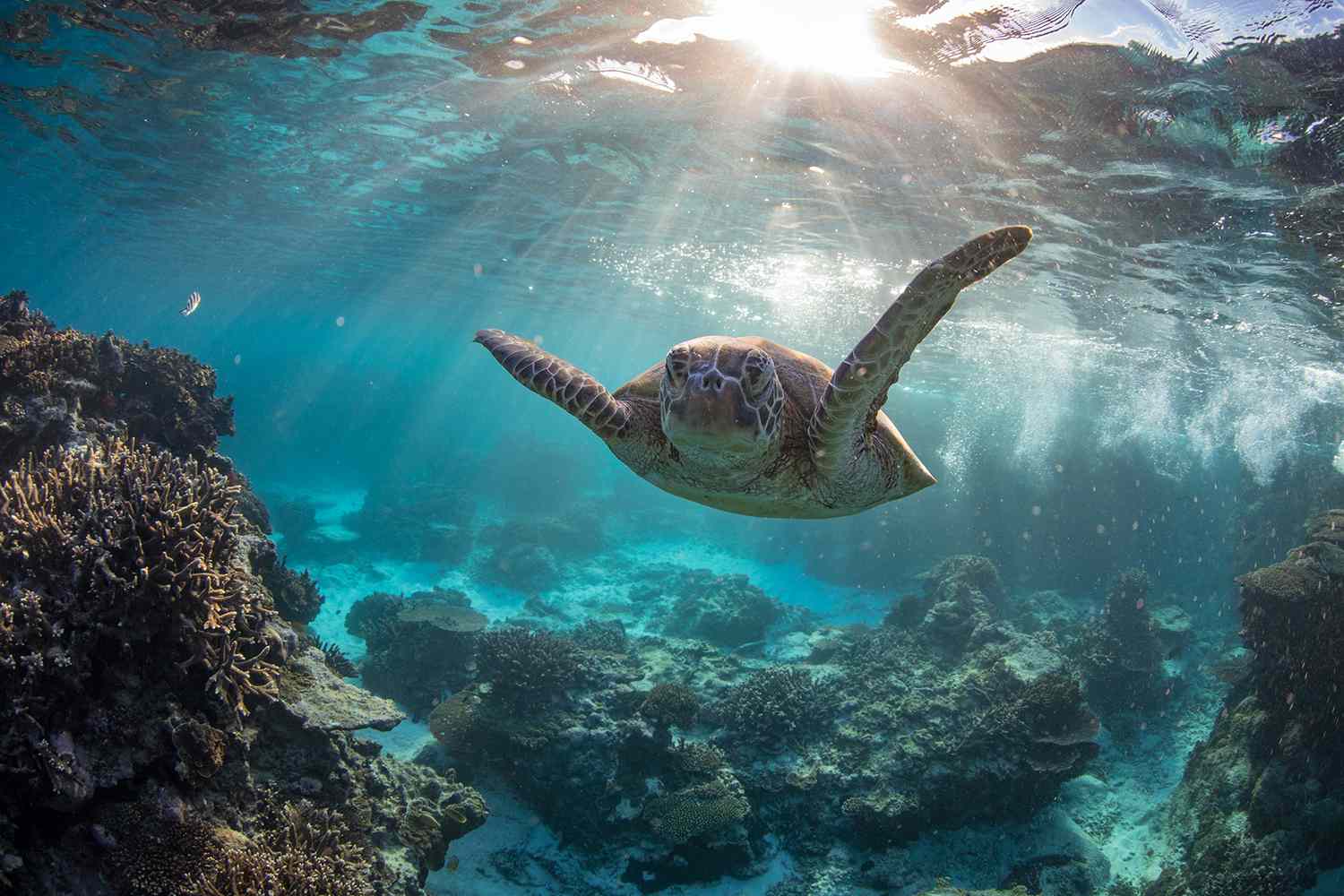- Best tourist destination: Lizard Island, Australia
- Best for biodiversity: Raja Ampat, Indonesia
- Best for shore diving: Bonaire
- Best for beginners: Key Largo, United States
- Best for advanced divers: Galapagos Islands, Ecuador
For the newly certified, the diving bug bites hard. Once you’ve experienced the magic of scuba, which gives you special access to the underwater world below, it’s natural to always have your mind on the next dive trip. I’ve experienced this awe myself while swimming with seahorses in Panama and gliding through clouds of sparkly blue and pink maomao in the kelp forests near Northland, New Zealand. Not to mention, when you dive with sustainable scuba shops or participate in citizen science programs, you are doing your part to protect the marine world. All it takes to scuba dive is a dive certification from authorities like the Professional Association of Diving Instructors (PADI), but if you don’t have one yet, you can always get certified on your trip!
Here, you’ll find 20 of the world’s best scuba diving destinations, including some of my favorite sites and picks from master divers.
Lizard Island, Australia
Nigel Marsh/iStockphoto/Getty Images
Few dive spots fascinate the world like the Great Barrier Reef, the world’s largest coral reef system. One of the best ways to experience it is Lizard Island, a luxe 40-suite escape with a PADI dive shop onsite. This getaway, set on the reef’s northern stretch, sees minke whales in July, humpbacks in August and September, and gargantuan cod that can reach up to six feet in length at the nearby Cod Hole dive site. Look for other favorites like nurse sharks, turtles, and giant clams, too. Lizard Island invites marine biologists on many scuba outings to teach guests about the wildlife. The Australian Museum also runs a Great Barrier Reef research station on the island.
Raja Ampat, Indonesia
Giordano Cipriani/Getty Images
The Raja Ampat archipelago in Indonesia is part of the Coral Triangle, an area that harbors over 1,300 species of reef fish and nearly three-quarters of the world’s coral species. The archipelago is also home to an inspiring conservation story, with biodiversity on the upswing thanks to dedicated patrolling efforts at the Misool Marine Reserve, which Mission Blue named a Hope Spot in 2017.
It’s among the most plentiful underwater ecosystems in the world, with more coral, fish, and mollusks than virtually anywhere else on the planet. Misool, a private island resort set in the heart of the conservation area, is the best scuba perch, with a vibrant house reef and access to over 60 dive sites reachable from the resort within one hour.
Bonaire
Douglas Klug/Getty Images
Myriad options for shore diving have made the cheery Caribbean island of Bonaire a must-visit among divers. The island boasts crystal-clear waters, vibrant corals, and plentiful marine life, including eagle rays, parrotfish, seahorses, turtles, and barracuda. With numerous dive resorts and easily reachable reefs, Bonaire is also an ideal place for beginners—in fact, it’s where I got dive certified.
Some of the most popular of the island’s over 100 dive sites include Salt Pier and Hilma Hooker. Don’t sleep on the nighttime dives here either; scuba-focused accommodation Buddy Dive Resort, for example, hosts several monthly twilight trips to see the sparkly ostracods.
Key Largo, United States
Stephen Frink/Getty Images
One of North America’s best diving destinations, the Florida Keys is just a two-hour drive from Miami. Explore Snapper Ledge, a beginner-friendly shallow reef that sees massive schools of snapper. Or visit the submerged Christ of the Abyss statue, a religious monument that’s now covered in coral.
Key Largo is also a good place to try your hand at hunting invasive lionfish (with the proper certifications). It’s also worth it to visit the Coral Restoration Foundation. The nonprofit’s dive and snorkel trips, as well as citizen science programs, help ocean lovers use their skills for good.
Galapagos Islands, Ecuador
Michele Westmorland/Getty Images
If the idea of swimming among dolphins, eagle rays, turtles, sharks, and penguins sounds enticing, head to the Galapagos Islands. This Ecuadorean archipelago has long lured wildlife lovers with a host of land animals like giant tortoises and blue-footed boobies. Its marine life is just as dramatic, but you’ll have to work to see it. The dive conditions can get rough with strong currents, and some outfitters will only take you if you’ve logged 50 or 100 dives.
For those who meet the credentials, a liveaboard is a great way to see the Galapagos. These boats provide access to hard-to-reach scuba spots like Darwin Island, where whale sharks, hammerheads, mantas, and penguins leave divers awestruck and ready for more.
Poor Knights Islands, New Zealand
Julian Gunther/Getty Images
Hailed by Jacques Cousteau as one of the best dive destinations in the world, the Poor Knights Islands in New Zealand are a collection of sea caves, underwater arches, and kelp forests. This hub for marine life, located off the Northland coast, sees orcas, dolphins, mating stingrays, sunfish, fantastical anemones, and high concentrations of pink and blue maomao.
Northland’s Dive! Tutukaka, located roughly 115 miles north of Auckland, runs full-day scuba and snorkel trips to the Poor Knights Islands. It’s also the country’s first PADI Adaptive Services Facility, which is equipped to assist divers of all abilities. Divers can stay overnight in the outfitter’s boutique Lodge 9 accommodation, too.
Rainbow Reef, Fiji
Jason Edwards/Getty Images
Fiji’s nickname, the “soft coral capital of the world,” does not disappoint—especially on the legendary Rainbow Reef. This 1,500-mile ribbon of marine life, located near the island of Taveuni, is a crayon box of soft and hard corals that draws some 2,300 species of fish. Lucky divers may spot reef sharks, turtles, and eagle rays while they’re here.
Visit with sustainable Sau Bay Resort and Spa, the closest resort to Rainbow Reef, which is one of the first PADI Eco Centers in the South Pacific. In addition to diving, Sau Bay guests enjoy complimentary “happy hour” nature sessions to learn about the reef and local restoration efforts.
Revillagigedo Islands, Mexico
Romona Robbins Photography/Getty Images
According to professional underwater photographer and ocean conservationist Jay Clue, it’s hard to top the Revillagigedo Islands like Socorro. “The Revilla is, hands down, some of the best big-animal diving on Earth,” he told me. “Its manta ray encounters are truly magical.”
Other magnificent draws to this archipelago in the Pacific, located 370 miles off of Mexico’s western coast, include whale sharks and humpbacks. A liveaboard boat, which typically runs trips between eight to 10 nights, is the best way to visit.
Cocos Island National Park, Costa Rica
Rodrigo Friscione/Getty Images
Set 340 miles off Costa Rica, the UNESCO World Heritage Site Cocos Island National Park allures marine biologists with its bounty of Pacific marine life. It’s a paradise for shark-loving divers, too, says Clue. “It’s widely considered one of the top shark-diving destinations in the world,” he said, noting the schools of hammerheads are particularly breathtaking.
A liveaboard dive boat is the best way to experience the region, which is the northern terminus of the vital Galapagos-Cocos Swimway, an underwater “highway” for migrating animals, such as sharks and turtles.
Laamu Atoll, Maldives
Michele Westmorland/Getty Images
Marine conservation organization Mission Blue named the Laamu Atoll in the Maldives a “Hope Spot,” an area designated as integral to the health of the ocean. This honor recognizes the work of Six Senses Laamu, a resort that runs sustainable dive tourism that helps safeguard this swath of seagrass meadows, mangroves, and reefs.
The atoll is also packed with biodiversity, including sea turtles, sharks, octopus, eagle rays, and over 400 species of fish. The PADI five-star dive shop offers classes, private dive experiences, and the chance to see manta rays on scuba outings with conservationists from Manta Trust and Deep Blue Divers.
Halkidiki, Greece
Marius Roman/Getty Images
Diving in Greece doesn’t get much more dazzling than Halkidiki, a trident-shaped land mass in the north near the city of Thessaloniki. Scuba divers can admire the remnants of the region’s volcanic past, with steep drop-offs and rock formations, as well as abundant and colorful sea life.
Look for octopus, groupers, tuna, lobsters, eels, and even turtles. Shipwreck explorations are also popular here, and they’re available via dive centers like the one operating from the Sani Resort, which is working to protect Greece’s nature as the first carbon-neutral resort in the country.
Visayan Islands, Philippines
R.M. Nunes/iStockphoto/Getty Images
The Visayan Islands of the Philippines, referred to more casually as “the Visayas,” are another one of Clue’s favorite dive spots. “It has everything from thresher sharks and whale sharks to some of the world’s best muck-diving (ocean-floor exploration) and macro-diving, as well as beautiful reefs, turtles, and schools of jacks,” he said.
The prime scuba season runs from about November to June, although thresher sharks can be seen here year-round. Try a liveaboard to pack in the sightseeing, or a dive resort like Evolution on Malapascua Island.
Tanna Island, Vanuatu
Gerold Grotelueschen/iStockphoto/Getty Images
Vanuatu is a playground for divers, with caves and corals that feel out of this world, particularly off the island of Tanna, the country’s diving hub. Tanna’s main dive center, Volcano Island Divers at White Grass Ocean Resort and Spa, is the first PADI Eco Center in Vanuatu. The team follows a regenerative approach to tourism that supports the community by training locals to become instructors. The visibility around the island is top-notch, and it’s a popular site for macro-photography with lots of colorful and tiny sea worms to look for, as well as the much larger and adorable manatee-like dugong.
Lake Motosu, Japan
Yim Man Wai/Getty Images
Fresh water can be just as enchanting as salt water, especially in locations like Japan’s Lake Motosu—a sacred body of water at the foot of Mount Fuji. The lake, located at nearly 3,000 feet of elevation, has restrictions against power boats. That means divers can swim in peace, with the chance to see sunken giant trees and marine critters like salmon, trout, and catfish. Outfitters like PADI five-star Motosuko Dive Resort help properly certified divers explore this high-altitude freshwater lake safely; this is an advanced dive, and it’s not ideal for beginners.
Lord Howe Island, Australia
Ignacio Palacios/Getty Images
Roughly 500 miles northeast of Sydney lies a treasure trove of radiant reefs. The location, Lord Howe Island, welcomes jet-setters to the world’s southernmost tropical coral reef and the planet’s largest sea stack, known as Ball’s Pyramid. It’s the only place in Australia where you can spot the six-foot Galapagos whaler shark; other potential sightings include lined catfish, angelfish, and hundreds of other fish species. Lodging here is limited, with only 400 beds available for visitors. To scuba, try PADI outfitter Dive Lord Howe.
Rarotonga, Cook Islands
chameleonseye/Getty Images
Dive into spellbinding underwater forests and coral gardens near Rarotonga, the main hub of the Cook Islands. Wildlife runs the gamut here, from angel and scorpionfish to sea turtles, whitetip reef sharks, and humpback whales between July and October. The island has over 30 dive sites, including some with sloping volcanic drop-offs for experienced divers who want to journey deeper. For accommodation, try the beachfront Sanctuary Rarotonga, which runs an on-site dive shop for easy reef access.
Niue
MollyBrownNZ/iStockphoto/Getty Images
The island of Niue may be small, but it doesn’t skimp on natural splendor. It’s a stargazing oasis as the only DarkSky-certified country in the world. This South Pacific island nation also boasts one of the world’s largest raised coral atolls. Come for the unique marine landscapes, including caves, chasms, and reefs, and stay for wildlife like humpbacks and spinner dolphins. Dive shop Niue Blue, a PADI Eco Center, offers both day and night tours and courses for beginner divers.
Fiordland, New Zealand
Skyimages/iStockphoto/Getty Images
This isn’t your average scuba dive. Fiordland, located along the craggy southern portion of New Zealand’s South Island, is a dramatic patchwork of towering granite peaks and remote fjords. It’s also among the wettest places on Earth—a feature that makes diving here even more enticing. Heavy rain creates a dark, tannin-stained top layer of seawater that invites typically deep-dwelling creatures closer to the surface.
Divers can also see sharks, rays, sea dragons, black and red corals, and dolphins. Scuba tours are limited here, and they do require a bit of effort, experience, and planning. For a new challenge, you could also try freediving—yes, without a tank—with boutique outfitter Wild Fiordland.
Andaman Islands, India
James R.D. Scott/Getty Images
For an intrepid dive adventure, try India’s Andaman Islands. The region’s remote turquoise waters lie well off the tourist track—but not for lack of beauty. The land masses, located between Thailand and India, delight with exceptional visibility, polychromatic reefs, coral gardens, and dozens of dive sites, including various cleaning stations for mantas near Barren Island.
More than 1,200 fish swim through these waterways, and diving is best from November to May; between June and October, you’re facing monsoon season. Book a stay at Big Tree Cottages, a five-star PADI dive resort with eight rooms embedded in the jungle in Chidiyatapu.
Marsa Alam, Egypt
Maria Korneeva/Getty Images
Red Sea fishing port Marsa Alam has evolved into one of Egypt’s hottest dive destinations, with all sorts of wildlife-sighting opportunities—think: turtles, dolphins, hammerhead sharks, tuna, and mackerel. Red Sea Diving Safaris is a PADI Eco Center that runs environmental programs giving back to the community and coastline, including waste- and water-management initiatives, reef checks, and litter cleanups in the local mangroves. Guests here have access to over 60 shore and off-shore dive sites, with day and night dives.


